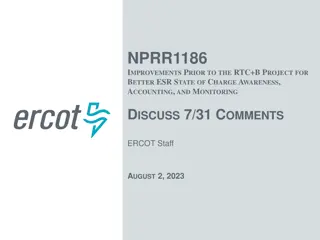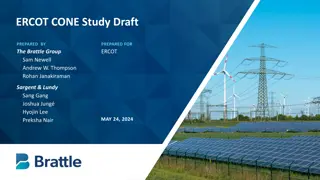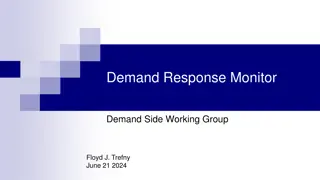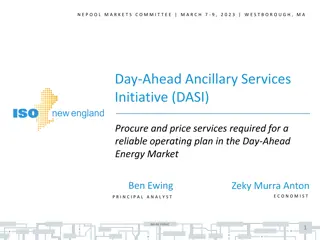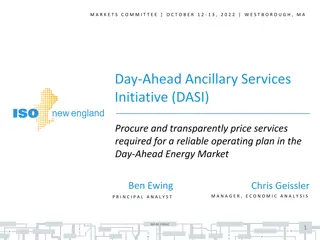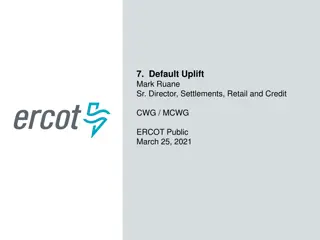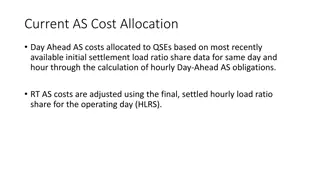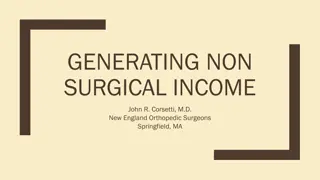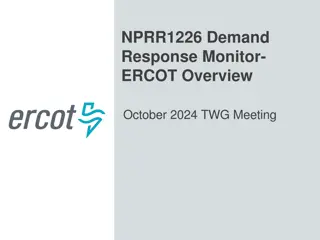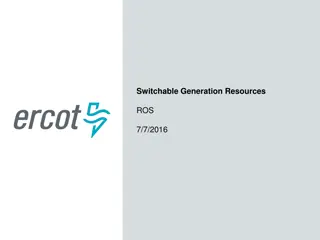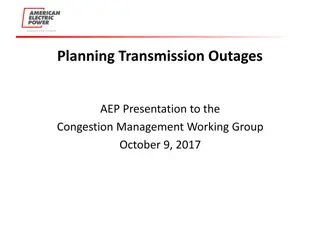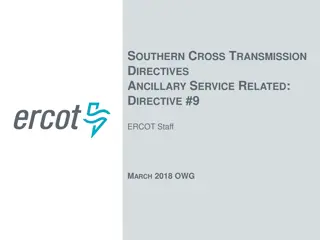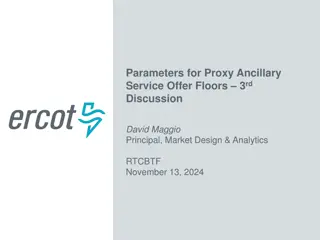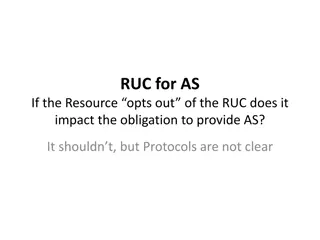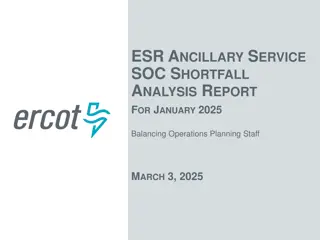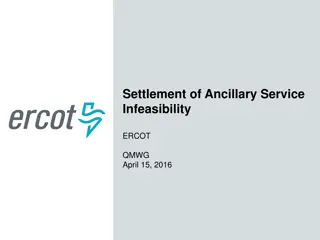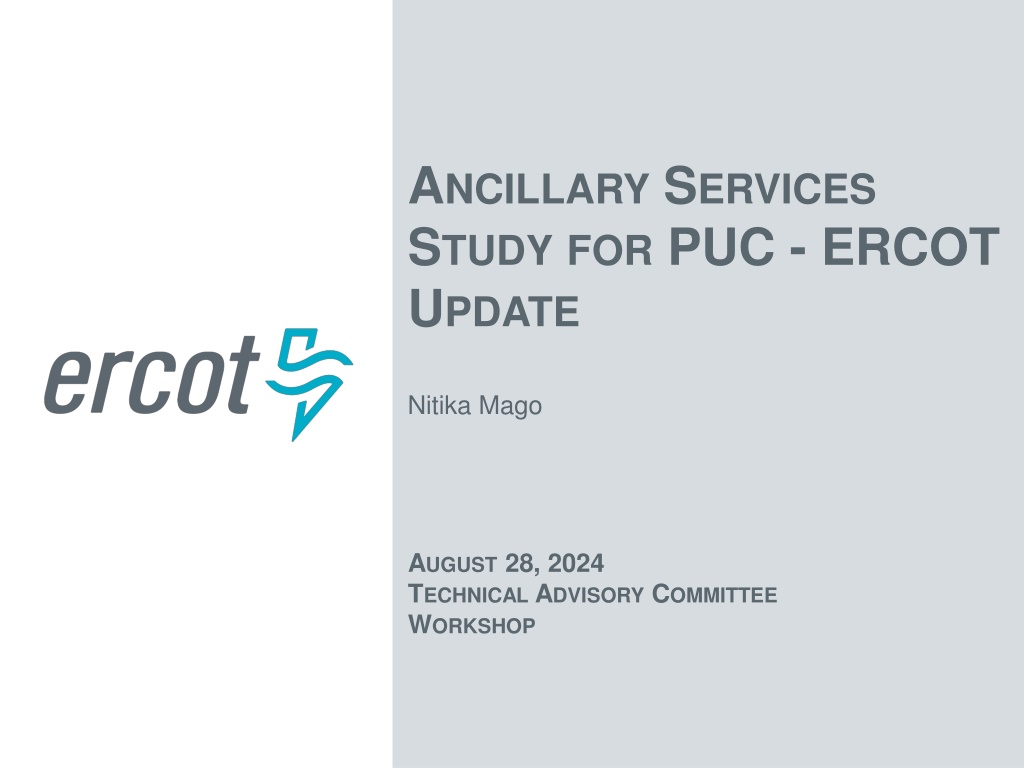
ERCOT Ancillary Services Study Overview
The ERCOT Ancillary Services Study provides an in-depth analysis of ancillary service products, ongoing and future changes affecting ERCOT's recommendations, and initial thoughts on the Independent Market Monitor's (IMM) analysis. The study aims to evaluate the types, volumes, and costs of ancillary services to ensure reliability in the ERCOT power region, in line with PUC requirements. Collaboration between ERCOT, IMM, and Commission Staff ensures a comprehensive review to meet the needs of the electricity market. Explore the scope and importance of ancillary services in maintaining grid reliability within the ERCOT Interconnection.
Download Presentation

Please find below an Image/Link to download the presentation.
The content on the website is provided AS IS for your information and personal use only. It may not be sold, licensed, or shared on other websites without obtaining consent from the author. If you encounter any issues during the download, it is possible that the publisher has removed the file from their server.
You are allowed to download the files provided on this website for personal or commercial use, subject to the condition that they are used lawfully. All files are the property of their respective owners.
The content on the website is provided AS IS for your information and personal use only. It may not be sold, licensed, or shared on other websites without obtaining consent from the author.
E N D
Presentation Transcript
ANCILLARY SERVICES STUDY FOR PUC - ERCOT UPDATE Nitika Mago AUGUST 28, 2024 TECHNICAL ADVISORY COMMITTEE WORKSHOP
OUTLINE OVERVIEW OF ANCILLARY SERVICE (AS) PRODUCTS ONGOING AND FUTURE CHANGES THAT IMPACTAS ERCOT S RECOMMENDATIONS UNDER THIS STUDY INITIAL THOUGHTS ON THE IMM S ANALYSIS SUMMARY RESPONSES TO TAC S QUESTIONS 2
PUCs Ancillary Service Study: Overview The Ancillary Services Study (Study) will assist the Public Utility Commission of Texas (PUC) in meeting the requirements of PURA 35.004(g) (enacted in Senate Bill 3 (87 R.S.)), which states, that: The PUC shall: (1) review the type, volume, and cost of ancillary services to determine whether those services will continue to meet the needs of the electricity market in the ERCOT power region; and (2) evaluate whether additional services are needed for reliability in the ERCOT power region while providing adequate incentives for dispatchable generation. The PUC s AS Study is the result of collaboration between the Electric Reliability Council of Texas, Inc. (ERCOT), the Independent Market Monitor (IMM), and Commission Staff (Staff). PUC Staff will file the Study in Project 55845, Review of Ancillary Services in the ERCOT Market, by September 30, 2024. PUC s Study Scope: Link 3 PUBLIC 3
Ancillary Services An Introduction Ancillary Services (AS) are an important mechanism for maintaining the reliability of the ERCOT Interconnection. The importance of AS has grown and continues to grow as variability and uncertainty of both supply resources and demands on the grid continue to increase. AS are needed to provide supplemental operational capabilities that would not otherwise be provided solely by, or explicitly incented by, the energy market. AS are procured to satisfy two purposes: 1. Meet certain supply and demand balancing related reliability objectives defined in NERC Reliability Standards, and 2. Reduce operational risks associated with variability and uncertainty. While ERCOT has fundamentally operated with three types of Ancillary Services, namely Regulation Service, Responsive Reserve Service (RRS) and Non-Spinning Reserve Service (Non-Spin) since start of the nodal market in late 2010, continuous improvements have been made along the way to adapt to ERCOT s changing Resource mix With growth in solar generation, to provide additional ramping capability that could counter changes in solar output, in June 2023, the 10-min response feature embedded within RRS was converted into a new reserve type, namely ECRS. 4 PUBLIC 4
Ancillary Service Products REGULATION SERVICE Reserved capacity that is deployed every 4 seconds to balance supply and demand and maintain frequency close to 60Hz between 5- minute SCED runs. RESPONSIVE RESERVE SERVICE Reserved capacity that is procured to respond to low frequency events typically triggered by generating unit trips. June 4, 2022 Unit Trip PUBLIC 5 5
Ancillary Service Products, Contd. ERCOT CONTINGENCY RESERVE SERVICE (ADDEDIN 2023) Capacity that can respond in 10 minutes to recover frequency, cover forecast errors or ramps and replace deployed reserves. 6 PUBLIC 6
Ancillary Service Products, Contd. NON-SPIN RESERVE SERVICE Capacity that can be started in 30 minutes to cover forecast errors, ramps or forced outages and replace deployed reserves until additional resources can be committed. (Additional Event Details) 7 PUBLIC 7
Primary Purposes of Ancillary Services FREQUENCY CONTROL OPERATIONAL RISKOF UNDER COMMITMENTOF RESOURCESTO MEET DEMANDPLUS UNEXPECTED VARIATIONS Need AS Need AS Moment-to-moment balancing of supply and demand; respond to imbalances caused by normal variability and 5-minute net load forecast errors Reserves that can quickly respond to intra-hour net load forecast errors and/or forced outages ECRS Regulation Service Reserves that can respond to multi-hour net load forecast errors and/or forced outages Non-Spin Arrest frequency decline caused by trip of large unit(s) Reserves that can respond to long-duration, multi-hour net load forecast errors and/or forced outages (Under Development) RRS DRRS Restore frequency following trip of large unit(s) ECRS Requirements based on NERC Reliability Standards, specifically, BAL-001-2, BAL-002-3 and BAL-003-2. Requirements based on risk analysis as described in the annual Ancillary Services Methodology. PUBLIC 8 8
Changing Resource Capacity Mix Capacity totals are based on the Installed Capacity Ratings for generating units. "Other" comprises of Biomass, Hydro, and Diesel. Planned generation projects are added to installed capacity after approval for synchronization to ERCOT Grid. Totals include Private-Use Network generators that export to the ERCOT grid, Distribution Generation Resources (DGRs), Settlement-Only Distribution Generators (SODGs), Unavailable Switchable Capacity, Extended Outage Units, and Mothballed Units. The percentages include capacity from planned projects with approval to synchronize. Data as of January 08, 2024 9 PUBLIC 9
Resource Mix Change Impact on Net Load Ramps As the installed capacities of intermittent resources has grown, the maximum net load (load minus wind minus solar) ramps in Real Time are increasing. Key Takeaway: As net load ramps increase, it increases the risk of encountering intra-hour issues that ECRS and Non-Spin need to mitigate. 10 PUBLIC 10
Resource Mix Change Impact on Net Load Forecast Error As the installed capacities of intermittent resources has grown, in the mean absolute error (MW) in net load (load minus wind minus solar) forecast is increasing. . Key Takeaway: Increased net load forecast errors caused, in part, by wind and solar capacity increases have increased the risks that ECRS and Non-Spin mitigate. 11 PUBLIC 11
Resource Mix Change Impact on System Inertia While installed renewable capacity tripled in the ERCOT region from 2013-2020, so far, the overall range and yearly minimum inertia have not changed drastically*. ERCOT has adapted AS due to the impact of resource mix changes on system inertia. In 2016, ERCOT began to vary the quantity by hour, based on the historic inertia in that hour, so that higher amounts of RRS were only procured when most likely to be needed and lower amounts were procured in other hours. In 2021, ERCOT system changes to implement fast frequency response (FFR) capability as a subtype of RRS. FRR helps reduce the minimum level of Inertia at which ERCOT grid can operate reliably. * Factors such as growth in ERCOT s minimum load, transmission constraints that limit renewable production and relatively low fuel prices have influenced the thermal unit commitments and total system inertia. Key Takeaway: ERCOT does not currently see a need for a new AS for inertia, but it is important to continue monitoring the trends in inertia, specially as ERCOT s renewable capacity grows and ERCOT s transmission grid evolves. PUBLIC 12
Avoiding Emergency Operations Following multiple days of high net load forecast errors and/or high generator forced outages in spring and early summer of 2021, ERCOT began operating with higher real-time reserves. The intention of this change in operating posture was to operate to a higher reliability threshold. Specifically, the goal was to have enough reserves to not only to avoid the need for loadshed but also to decrease the likelihood of the need for Emergency Operations due to insufficient reserve capacity. Initially, this change was accomplished by committing additional generation through the Reliability Unit Commitment (RUC) process. Market Participant feedback led ERCOT to seek the additional reserves through increased procurement of AS quantities in July 2021 and other changes in AS Methodology beginning January 2022. Effectively, since 2022, AS Methodology uses avoiding the need for Emergency Operations (Watches, EEA) as its event/criteria for determining AS quantities. Key Takeaway: AS requirements have not only increased to cover risks of ramps and forecast errors, but also due to policymakers desire for ERCOT to operate the system more conservatively 13 PUBLIC 13
Recent Trends in Ancillary Service Quantities The amounts of AS procured have increased in recent years due to (1) increases in intra-hour and hourly net load variability and uncertainty and (2) a policy change in 2021 to maintain an acceptable level of reliability risk. 14 PUBLIC 14
Impact of growth in Demand on frequency control ERCOT is seeing significant load growth within ERCOT s footprint. ERCOT is tracking over 49,365 MW of large loads (greater than 75 MW) in various stages of development. Larger volumes of growth are expected in cryptocurrency mining facilities, data centers, hydrogen/industrial facilities and oil and gas facilities. IMPACTOFQUICKLARGELOADFLUCTUATIONSON BALANCING Some large loads, can quickly change consumption based on changes in ERCOT wholesale prices. These changes in consumption may occur in manner not coordinated with ERCOT and could cause a significant imbalance between load and generation leading to frequency instability on the ERCOT system. IMPACTOFSUDDENLOADFLUCTUATIONSORTRIPS ONFREQUENCY Sudden reduction in consumption either because of system faults or equipment failure can cause an imbalance between load and generation, which could cause sudden frequency instability on the ERCOT system. December 7, 2022 At this time, ERCOT is not pursuing a new type of AS to respond to these events Through mid-2024, ERCOT has not observed reliability problems due to large load consumption ramps. Key Takeaway: The impact of large load behavior on frequency control is an emerging trend which ERCOT will continue to monitor. AS changes are not warranted at this time. PUBLIC 15 15
Pending Future Changes Implementation of Real-Time Co-optimization (RTC) (in late 2025 or early 2026), and DRRS (sometime after RTC), a new type of AS, are expected to have significant impacts on AS. RTC AS will be co-optimized with energy every five minutes in the Real-Time Market. Commitment processes will ensure sufficient qualified Resources will be available to provide AS More efficient allocation of AS and energy production among available, qualified Resources in real- time. Deployment changes to AS. DRRS Intended to cover risks associated with historical variations in generation variability, including intermittency of non-dispatchable generation facilities and forced outages. Resources providing DRRS must be capable of being On-Line and dispatchable within two hours of being called on for deployment, must have dispatchable flexibility, and must be capable of running for at least four hours. NPRR1235 to implement the framework and requirements for DRRS in the ERCOT market is currently moving through the ERCOT stakeholder process. ERCOT will begin discussions with stakeholders regarding the methodology to determine procurement quantities of DRRS after NPRR1235 has been approved by the PUC. 16 PUBLIC 16
Summary of ERCOTs Recommendations Existing AS products and the forthcoming DRRS are sufficient for meeting the system s reliability needs. ERCOT does not recommend additional AS products at this time. ERCOT recommends continuing to monitor impact of resource mix on system inertia and impact of load growth on frequency control. As trends evolve there may be a need to consider new AS and/or Regulation Service methodology changes. ERCOT recommends to continue to use current mechanisms that best quantify the risks and meet applicable NERC reliability standard requirements for Regulation, RRS, and the frequency-response portion of ECRS. ERCOT recommends exploring two potential improvements: 1. Revamp the methodology used to calculate non-frequency recovery related ECRS and Non-Spin quantities to use a probabilistic framework for quantifying reliability risks that these reserves are required to cover; and 2. Examine the benefits of determining some portion of AS quantities closer to the Operating Day based on days-ahead forecast conditions rather than strictly through an annual calculation. Key Takeaway: ERCOT is recommending two changes: 1. Develop probabilistic method to calculate appropriate quantity of Non-Spin and ECRS (the non-frequency responsive portion) 2. Determine final AS quantities closer to operating day (within forecast window) rather than annually 17 PUBLIC 17
ERCOT Recommendation #1 Full Statistical Analysis of risk 1. Change the methodology to calculate non-frequency-restoration portion of ECRS quantities and Non-Spinquantities to use a full statistical analysis of risks Current methodology uses a quasi-statistical approach based on combined risk percentiles that are stacked on top of each other. A full statistical approach will compute a single, combined risk for each AS type. Full Statistical Monte Carlo Analysis of Reserve Need Forced Outages/ Derates (Month:x, HE:y) Load Forecast Error (Month:x, HE:y) MC Draws Distribution of Reserve Need (Month: x, HE: y) Wind Forecast Error (Month:x, HE:y) Net-Load Forecast Error (Month:x, HE:y) MC Draws MC Draws Available Non- AS Headroom (Month:x, HE:y) Solar Forecast Error (Month:x, HE:y) *For illustration purposes only PUBLIC 18
Full Statistical Analysis OPEN Questions How should the available headroom/capacity that is not providing AS be accounted in this analysis? For example, weather forecast errors typically cause corresponding errors in load, wind, and solar forecasts, but are generator trips correlated to forecast errors, also? Further, should historic headroom capacity be accounted for in this analysis? If so, is the historic headroom capacity of the online generation fleet correlated to other factors? How should increases in variability and uncertainty due to wind, solar, and load growth, as well as future changes in generator commitment patterns be accounted for in the methodology? Historically, as the Intermittent Renewable Resource (IRR) fleet s installed capacity has increased, both variability and uncertainty in net load have increased, and relying on historic error alone may not sufficient. What event/criteria should each AS be setup to cover? Is the criteria simply a matter of avoiding loss of load? Or should there be criteria related to avoid entering into an Energy Emergency Alert (EEA) or a Watch due to insufficient reserves? How should avoiding the need for manual operator actions be included in the criteria? How should temporal constraints and cumulative factors be accounted? The possibility of multiple generator trips across multiple hours (as occurred on May 13, 2022, for example) presents a risk that needs to be covered by AS.(Cumulative forced outages) AS is needed until other generators can be started or until the conditions causing the need for the reserves from AS change. How should this be considered in the analysis? (Event duration/temporal constraints) Increasingly, AS is being provided by duration-limited resources (battery energy storage). There is some risk that battery energy storage resources providing AS deplete their storage capacity during a multi-hour forecast error event, even if they are meeting all applicable requirements. Should not being able to charge be accounted as a risk in this analysis? (lack of energy considerations) How much can other types of AS reserves be counted on to address risks for a given AS product? For example, should some or all of ECRS be counted towards meeting the reserve needs covered by Non-Spin? Key Takeaway: ERCOT is generally supportive of doing a full statistical probabilistic analysis to determine AS quantities. Several key questions that have to be carefully considered to setup the appropriate model for this analysis. Responses to these questions directly impact the volume of reserves procured and operational actions needed to continue operations. As an example, setting reserves too low could result in lower self commitment and tools like Unit Commitment may be necessary to cover the overall expected operational risk on such days. For proper balance Stakeholder and potentially policymaker input on these is essential. 19 PUBLIC 19
ERCOT Recommendation #2 Dynamic AS quantity determination 2. Examine the benefits of determining some portion of AS quantities closer to the Operating Day based on days-ahead forecast conditions rather than strictly through an annual calculation Net load variability is expected to increase substantially in the future and can also differ significantly on different days and hours. The difference between true minimum quantities or typical quantities of some AS products and the quantity needed to meet reliability risk objectives for worst-case or near worst-case conditions will be greater in the future. This type of approach, allows to set AS quantities based on a closer to Real Time assessment of operational risks. A possible framework could involve setting minimum, expected, and maximum AS quantities in an annual study and then setting the actual quantity for the Operating Day before the Day Ahead Market runs. Key Takeaway: ERCOT should work with stakeholders to reexamine the tradeoffs between the certainty of calculating AS quantities on an annual basis and the efficiency of calculating at least some portion of AS quantities closer to the operating day. 20 PUBLIC 20
Response to the IMMs Analysis and Recommendations ERCOT notes that much of the reduction in AS quantities that IMM s analysis proposes is NOT due to better analytics, but due to modifying previous policy decisions in a way that drives lower AS quantities. Modifying these decisions under ERCOT s current AS Methodology would lower the quantities as well. The IMM s policy decisions (at least the ones identified from what we understand of their analysis so far) are: Expect Periodic Emergency Operations: The fundamental criteria the IMM is using for determining AS quantities is avoiding load-shed, whereas as noted earlier, ERCOT intentionally increased AS quantities since 2021 using a criteria of avoiding potential Emergency Operations (Watches, EEA) when Resources are available. Increase the Use of RUC Rather Than Procuring AS: The IMM is recommending that Non-Spin should only be used to cover risks in a one-hour timeframe, whereas the current AS methodology covers risks that have a six-hour lead time. Further, the IMM proposes that RUC can be used to cover risks that have a longer lead time. Rely on Non-Obligated Resources for Reliability Services: The IMM recommends taking advantage of headroom from all Resources including those that don t have any obligation to be available. Historically, ERCOT has set AS quantities based on as estimation of the risks. This approach guarantees that Resources with the right operational characteristics will be available to cover these risks and does not rely on past actions or behaviors from Market Participants which may or may not continue. Key Takeaway: Any policy decision(s) to expect periodic emergency operations, increase the use of RUC rather that procuring AS, and rely on non-obligated Resources for reliability services must be considered and decided by policymakers and should not be hidden within modeling assumptions. 21 PUBLIC 21
Response to IMMs Analysis and Recommendations EXCERPTSFROMIMM S RECOMMENDATIONS ERCOT S PERSPECTIVE (Slide 4)ERCOT s current AS procurement methodology is based on deterministic metrics that do not reflect a probabilistic analysis of reliability risks. ERCOT is generally supportive of the idea of doing a full statistical probabilistic analysis to determine AS quantities, in order to better account for the joint probabilities of the various uncertainties. (ERCOT s Recommendation #1). (Slide 5) AS procurement volumes should be informed by a probabilistic analysis of the reliability risks addressed by the AS products There are OPEN questions on the analysis approach which require stakeholder and policymaker feedback. (Slide 5) ECRS and NSPIN procurement volumes can be substantially reduced on average while maintaining reliability: These conclusions are drawn based on the IMM s recommendation of using a loss of firm load probability as the event/criteria that should be used to set AS reserve targets. This approach is essentially advocating to depend on periodic emergency operations. ERCOT considers the event/criteria to be used for setting AS requirements as an OPEN question. (Slide 5) Larger benefits can be achieved by making the AS procurement quantities dynamically based on the factors that tend to affect the reliability risks ERCOT is generally supportive of the idea of determining some portion of AS quantities closer to the Operating Day based on days-ahead forecasted conditions. (ERCOT s Recommendation #2) This approach is dramatically different from current approach. Input from stakeholders is essential in establishing and transitioning to such an approach. (Slide 5) ESR duration requirements are currently set arbitrarily high and should be lowered to one hour, consistent with the risks they address ERCOT considers the current duration requirements to be appropriate under the existing paradigm. Slides 31 and 32 in Appendix demonstrate some analysis ERCOT conducted in the past on this topic. ERCOT also agrees that with the system changes that are being teed up with RTC, duration for AS is an important topic that should be reconsidered at the appropriate time. A probabilistic assessment of the risk may need to be included in the analysis. 22 PUBLIC 22
Response to IMMs Analysis and Recommendations, Contd. EXCERPTSFROMIMM S RECOMMENDATIONS ERCOT S PERSPECTIVE (Slide 6) Model Approach: Determine how reserve levels correspond to the loss of load probability (LOLP) based on randomly occurring forced generator outages and load and renewable output forecast errors. - Forced generator outages cause an immediate reduction in available reserves as they are deployed - Under-forecasts of net load (load renewable output) can lead to under-commitment of dispatchable resources and fewer available reserves The frequency iterations with load shedding determines the LOLP The IMM is recommending to only consider impact of forced outages that occur within an hour as at risk capacity and cover the continued impact of a forced outage indirectly as reduced headroom. Further the IMM recommends taking advantage of headroom from all Resources that are committed including those that don t have any obligation to be available, i.e., count on overcommitment. Historically, ERCOT has set AS quantities based on as estimation of the risks. This approach guarantees that Resources with the right operational characteristics will be available to cover these risks and does not rely on past actions/behavior from Market Participants which may not may not continue. The changes IMM is recommending are important policy decisions that should be carefully considered. (Slide 8) To accurately determine when load-shedding would occur in the model iterations, it must recognize all available supply ERCOT s considers these issues to be part of the OPEN questions on the analysis approach which require stakeholder and policymaker feedback. (Slide 14) Forecast errors become evident over longer time horizons are better addressed by commitment of longer-lead time resources through the RUC The IMM is recommending that Non-Spin should only be used to cover risk that have a one-hour lead time, whereas the current AS methodology covers risks that have a six-hour lead time. Further the IMM proposes that RUC can be used to cover risks that have a longer lead time. The IMM is proposing an approach that is counter to the guidance from policymakers and stakeholders. Implications of such a policy change should be carefully reconsidered. (Slide 22) Ideally, the AS methodology should account for changes in the risk profile associated with the rapidly changing resource mix, including: - The rapidly increasing penetration of intermittent resources, which will likely increase the magnitude of the net load forecast errors, and - The increase in large flexible loads that tend to mitigate system risk by self-curtailing when conditions become tight ERCOT considers accounting for the impact of growth in installed capacities on risks for which AS is needed as an important question. 23 PUBLIC 23
Summary Existing AS products and the forthcoming DRRS are sufficient for meeting the system s reliability needs. Further: ERCOT does not recommend additional AS products at this time. ERCOT recommends continuing the current mechanisms that best quantify the risks and meet applicable NERC reliability standard requirements for Regulation, RRS, and the frequency- response portion of ECRS. ERCOT recommends exploring a full statistical analysis of risk for computing the non-frequency recovery portion of ECRS and Non-Spin. ERCOT recommends exploring the benefits of determining some portion of AS quantities closer to the Operating Day based on days-ahead forecasted conditions. ERCOT notes that implementation of changes as an outcome of this Study is dependent on addressing the OPEN questions and software tool development. Any changes will not be incorporated in the 2025 AS Methodology due to timing considerations. Regarding the IMM s analysis, ERCOT agrees with the proposed probabilistic framework but notes that much of the reduction in AS quantities the IMM proposes is NOT due to better analytics but is rather due to modifying previous policy decisions (such as avoiding emergency operations, procuring AS rather than RUC, and not relying on non-obligated Resources) in a way that drives lower AS quantities. Any policy decision(s) to expect periodic emergency operations, to increase the use of RUC rather that procuring AS, or to rely on non-obligated Resources for reliability services must be considered and decided by policymakers and should not be hidden within modeling assumptions. 24 PUBLIC 24
Response to TAC Feedback TAC Feedback ERCOT S PERSPECTIVE 1. How does a probabilistic approach help us deal with the problem of responding to operational risks when resources with right characteristics are not available (through self commitment)? How does RTC? 1. As far as incenting the self commitment and having resources online is concerned, careful setup of the probabilistic analysis under both ERCOT Recommendations will be important. RTC helps improve operational efficiencies by re-procuring AS every 5-minutes. Under RTC as well, from a self commitment perspective, it is important to ensure that the AS Demand Curves RTC uses are setup to appropriately represent the operating philosophy guidance from policymakers. 1. What are plans to develop a holistic portfolio approach in quantifying minimum quantities for each AS product? A portfolio approach ensures that overlaps between products are minimized, that products complement each other and reliability is optimized as a portfolio. The ideal portfolio approach likely needs to use probabilistic methods to simulate risks under uncertainty. Can ERCOT start to provide not just minimum quantities but also a quantity range or distribution for each AS product to help market participants have a better understanding of quantity ranges? How do we ensure new or amended AS products like DRRS do not cause similar issues to ECRS (artificial scarcity, withholding from SCED, secondary impacts such as making SCED go short faster than it should etc.)? What benchmarks or metrics can be used by IMM or ERCOT to benchmark AS or their performance to ensure ERCOT is not over- procuring AS for example and that AS quantities and types are reasonable both ex-ante and ex-post. 1. This is something that has not been an intention or explicit goal of this effort. The datasets that are contemplated to be used for ECRS, Non-Spin (and even DRRS) risk analysis will be designed such that these are distinct, so that the probabilistic risk assessments for each as are distinct. ERCOT is generally supportive of this and can develop this further under work tied to ERCOT s Recommendation #2. Operationally, DRRS is not same as ECRS. Under the proposed NPRR1235, DRRS will be implemented on top of RTC; it will be procured in the DAM and deployed via RUC. An important factor for this discussion could be the demand curve for DRRS in DAM. ERCOT is open to exploring metrics that other similarly situated system operators may be using in this regard to that the extent that those metrics a valid for a single-balancing authority interconnection with limited ties. 2. 2. 3. 3. 4. 4. 1. 1. From an ERCOT perspective, ERCOT agrees that it may be too soon at the current moment to fulfill this request. At the appropriate time, ERCOT will be happy to share analysis that can show impact of the proposed probabilistic approach. The IMM may have a response in this. This request might be premature but if the IMM has their Monte Carlo model prepared it would be interesting to see a backcast on AS plan amount distributions it would ve produced during some historical time period. 25 PUBLIC 25
Response to TAC Feedback TAC Feedback ERCOT S PERSPECTIVE 1. How do you incorporate DRRS into the analysis, particularly when looking at AS from a historical perspective? Are you accounting for continued conservative operations currently and after implementation of RTC? Please show examples of what procurement close to the operating day looks like and how any procurement changes differ from the status quo. Do you anticipate having duration requirements and state of charge requirements for ancillary services and if so, what do those look like and to which services would they apply? ERCOT seems to view ancillary services AS a suite of products to solve operational concerns while the IMM seems to view ancillary services more AS a problem to be minimized. Is the IMM analysis for ancillary services and the methodology looking at the products from the perspective of ERCOT s concerns or from a perspective of how the IMM thinks ERCOT should view them? If ancillary services are expected to provide resource adequacy in the market, how will they do that and what changes are needed to ensure resource adequacy to meet the reliability standard now and into the future? NPRR1235 is still being considered in the stakeholder process. ERCOT will begin discussions with stakeholders regarding the methodology to determine procurement quantities of DRRS after NPRR1235 has been approved by the PUC. Refer to Slide 13 and Slide 22 for ERCOT s perspective. In initial discussions, under this approach, the quantity determination would occur before DAM for the Operating Day. The ideal timeframe for determine AS needs fall in the 7 Days Ahead to 3 Days Ahead timeframe. Additional analysis will need to be done to narrow down the exact timing for running this analysis. Worth noting that this approach s effectiveness can significantly improve with improvements in 2 to 7 days out COP submissions. Duration for AS is an important topic that should be reconsidered at the appropriate time. 5. and 6. expect IMM to answer. 1. 2. 3. 2. 3. 4. 5. 4. 6. 1. I think our fundamental question is what is the basis for each of the services and what data is being/will be used to support the procurement amounts. This needs to be looked at both in terms of the individual services and their overall impact as a portfolio. Someone suggested earlier that ERCOT provide a range and not just minimum A/S quantities and I think that is another way of saying this what are the drivers and what are the limits of the justified procurements based on those drivers (both max and min). 1. The material in Slides 18 through 20 addresses this question at a high level. ERCOT is generally supportive of this and can develop this further under work tied to ERCOT s Recommendation #2. 2. 2. 26 PUBLIC 26
Response to TAC Feedback TAC Feedback ERCOT S PERSPECTIVE 1. We would like to make sure we understand an overlap in use cases between RRS, ECRS, non-spin and DRRS and are not duplicating resources through qualifications 1. RRS quantities will continue to be determined using a methodology that helps meet ERCOT s obligations under NERC s BAL standards. Further, the datasets that are contemplated to be used for ECRS, Non-Spin (and even DRRS) risk analysis will be designed such that these are distinct, so that the probabilistic risk assessments for each as are distinct. Lastly, Duration for AS is an important topic that should be reconsidered at the appropriate time. 1. Conservative operations how will ERCOT reconcile the reliability need as determined in the AS methodology with the reliability impacts of conservative operations? Are the two aligned or are we over buying AS and over committing via RUC? AS providers as we holistically review the AS product portfolios, we need to include the reliability benefits of the types of AS providers. Generation Resources, Load Resources, Energy Storage Resources, all provide reliability benefits in their own ways and we should review the best ways for these Resources to participate in the AS markets. Closer to real time a framework where ERCOT establishes a yearly baseload amount of AS and defers the determination of procuring additional AS closer to real-time may be more efficient, but may introduce hedging challenges. We should explore the balance of this concept and have a deliberative discussion on this concept. Long-term AS auction perhaps a longer term concept to consider - Is there any benefit to holding long term (yearly/quarterly/monthly) AS markets? There are bilateral options for long-term hedging, but a centrally cleared long term marketplace may be worth considering. 1. As noted in Slide 13, the AS methodologies developed since 2021 have included changes that take the objective of avoiding EEA into account. These changes were meant to reduce the volume of RUCs initiated for committed capacity margin and not eliminate RUCs. ERCOT recommends that the event criteria that AS is needed for should be basis for the full statistical model that is eventually built. ERCOT agrees and will include discussion on this topic in its final report. ERCOT agrees that Stakeholder input is important on this vetting this concept. ERCOT is open to talking about this further but don t have a specific recommendation at this time. 2. 2. 3. 3. 4. 4. 27 PUBLIC 27
Response to TAC Feedback TAC Feedback ERCOT S PERSPECTIVE 1. What are the ERCOT and IMM analyses respectively and comparatively solving for? The discussion around ECRS over the past year has highlighted that ERCOT has a certain set of concerns and views their AS suite as providing tools to address those in real-time, whereas the IMM s analyses have largely had the benefit of hindsight. Are they both working towards the same objective(s) or different ones? If we know up front whether the IMM is solving for ERCOT s concerns or what the IMM thinks ERCOT s concerns should be, that will help color the digestion of the comparative analyses. Are they incorporating reliability standard requirements from PURA 39.159(b) and the AS suite s contribution to meeting those requirements? How are the respective analyses modeling DRRS and in what quantities? How are they considering DRRS contribution to the meeting the reliability standard? Are they evaluating the resource adequacy requirements of PURA 35.004(g)(2) (i.e., evaluate whether additional services are needed for reliability in the ERCOT power region while providing adequate incentives for dispatchable generation )? Are they evaluating ancillary service cost allocation in their analyses? How are the respective analyses considering conservative operations post-RTC? Do they incorporate a Committed Capacity Margin objective? How are they modeling duration qualifications for each AS product post- RTC? ERCOT had hinted at considering procuring some amount of AS closer to the operating day I presume they would still be procuring a minimum amount on the annual methodology basis and then increasing their procurements closer to the OD. They can already do that today, so what is the difference between what they are considering and status quo? Would they provide some advance notice to the market of near-term changes to the AS Plan (e.g., days/weeks in advance) or would it just be sprung on the market in the DAM? 1. ERCOT appreciates this question. ERCOT is supportive of using a statistical analysis that utilizes a single combined risk for which ECRS and/or Non-Spin are needed. There are several open questions that are essential to answer. Some of these questions poke at existing policy decisions such as use of historical resource availability. No. ERCOT expects to begin discussions with stakeholders regarding the methodology to determine procurement quantities of DRRS after NPRR1235 has been approved by the PUC. Slide 15 summarizes ERCOT s perspective on this topic. This topic is out of scope for the work that was conducted under the PUC s AS Study effort. ERCOT considers the event/criteria to be used for setting AS requirements including whether or not avoiding the need for emergency operations when resources are otherwise available should be incorporated as a criteria as an OPEN question. One way of understanding the difference between what ERCOT is able to do today under the current protocol and methodologies and what is contemplated under ERCOT s Recommendation #2, is how often a change in AS quantity is made close to real time. Under today s paradigm ERCOT rarely makes changes to AS quantities closer to real time. Under Recommendation #2, ERCOT will be making changes to the quantities much more frequently by taking into account the latest forecasts and expected uncertainties. Transitioning to an approach like this is something that will need Stakeholder inputs and AS Methodology (and possibly protocol) changes. 2. 3. 2. 4. 5. 3. 6. 4. 7. 5. 6. 7. 28 PUBLIC 28
Response to TAC Feedback TAC Feedback ERCOT S PERSPECTIVE 1. Industrial customers support the IMM s recommendation that ERCOT use a model approach that incorporates seasonality and time of day to inform procurement targets. Through modeling, ERCOT should clearly define the reliability need and then allow resources to compete to fulfill that need. ERCOT s existing methodology should be refined to more efficiently procure ancillary service amounts in a way that minimizes unnecessarily withholding resources from the energy market where it is not justified by reliability needs. Importantly, if ERCOT uses sound reliability modeling to drive its AS procurement, ERCOT can maintain system reliability without over-procuring ECRS and driving up real-time prices. To the extent that the market must price reliability needs, ERCOT should utilize the ORDC or the future ancillary service demand curves (under RTC), rather than through unnecessary withholding or excessive ancillary service procurements. How many Resource Entities provided each type of ancillary service in 2023? How many MWhs of each service did each Resource Entity provide? What was each Resource Entity's registration type at ERCOT? Were any of the Resource Entities Resources co-located with other Resource Entities Resource and/or were the Resources they represent co-located? What is the timeline for conducting the cost allocation studies required by PURA 35.004(h) and 39.1593? 1. ERCOT appreciates this feedback. ERCOT notes that with the implementation of RTC, RTC s SCED will utilize system conditions and AS Demand curves to dispatch energy and procure AS. This approach should eliminate some of the inefficiencies that exist in the current market design. 1. 1. to 5. These topics are out of scope for the work that was conducted under the PUC s AS Study effort. 2. 3. 4. 5. 29 PUBLIC 29
APPENDIX PUBLIC 30 30
Sustained Net Load Up Ramp Analysis In analyzing historical* sustained net load up ramps that were 3,000 MW/hr or more in magnitude, ~99% events occurred during high risk hours** and lasted 2 hours or less All events that occurred during high risk hours and lasted 4 hours or less. 4,500 MW/hr or more in magnitude, All events that occurred during high risk hours and lasted 2 hours or less. *Between January 1, 2018 and July 31, 2021; excludes February 15 19, 2021. **High risk hours are hours where the risk of net load up ramp is high. These are computed using a methodology that is consistent with the current Non-Spin methodology. 31 PUBLIC 31
Sustained Net Load Under Forecast Error Analysis In analyzing historical* sustained net load up under forecast errors that were 4,000 MW or more in magnitude ~81% events occurred during times when Real Time headroom** was low*** and lasted 2 hours or less ~97% events occurred during times when Real Time headroom was low and lasted 4 hours or less. All events occurred that during times when Real Time headroom was low and lasted 6 hours or more. 4,500 MW or more in magnitude ~89% events occurred during times when Real Time headroom was low and lasted 2 hours or less. All events that occurred during times when Real Time headroom was low and lasted 4 hours or less. 6,250 MW or more in magnitude All events that occurred during times when Real Time headroom was low and lasted 2 hours or less. *Between January 1, 2018 and December 31, 2020 **Real Time Headroom = Total Online HSL + Offline Non-Spin Actual Load ***Real Time headroom less than 5,000 MW 32 PUBLIC 32


